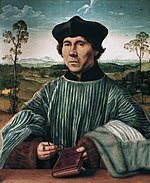Gilbert Bourne
William Barlow | |
|---|---|
| Successor | Gilbert Berkeley |
| Personal details | |
| Died | 10 September 1569 Silverton, Devon |
| Previous post(s) | Archdeacon of Bedford |
Gilbert Bourne (date of birth unknown; d. 10 September 1569 at
Life to the death of Mary I
Bourne was son of Philip Bourne, of Worcestershire. Entering the University of Oxford in 1524, he became a Fellow of All Souls in 1531, proceeded in Arts in 1532, and in 1543 was admitted to the degree of Bachelor of Divinity,[1] having in 1541 been named prebendary of Worcester, on the suppression of the old monastic chapter there.[2]
Moving to London in 1545, Bourne became a prebendary of
During Bourne's brief episcopate, he seems to have taken no part in the
Under Elizabeth

At the beginning of Elizabeth's reign Bourne was kept away from London by illness and official duties, and he is only mentioned once as present in the Parliament. For this reason he was one of the last bishops to be deposed, and he was even named amongst those first commissioned to consecrate

For a few months Bourne was left in Somerset, apparently as a prisoner on parole; but on 31 May 1560 he received a summons to appear within twelve days before Parker and the Commissioners in London. He set out, as his reply to Parker shows, well knowing what to expect, and on 18 June was committed to the Tower of London as a close prisoner, joining five other bishops already confined there. He remained in the Tower for three years, for most of that time in solitary confinement, when an outbreak of the plague in September 1563 caused him and his companions to be for a time transferred into the keeping of certain of their Anglican successors in office; Bourne himself was apparently committed to that of Bishop Nicholas Bullingham of Lincoln.[2]
There began that continual "tossing and shifting" of the deposed prelates "from one keeper to another, from one prison to another", which
He is one of the "Eleven Bishops", a picture of whose prison was allowed by Pope Gregory XIII to be erected in the English College church at Rome, amongst pictures of the English Saints and Martyrs, with an inscription declaring that they "died for their confession of the Roman See and Catholic faith, worn out by the miseries of their long imprisonment".[2]
References
- ^ Bludworth-Brakell Pages 142-170 Alumni Oxonienses 1500-1714
- ^ a b c d e f Herbermann, Charles, ed. (1913). . Catholic Encyclopedia. New York: Robert Appleton Company.
- ^ Nichols, John Gough, editor. (1852). Chronicle of the Grey Friars of London. London: Printed for the Camden Society by J.B. Nichols and Son, printers. p. 83 and footnote 'e'. The Internet Archive website Retrieved 18 June 2019.
Further reading
- Allen, Defence of Catholics (Ingolstadt, 1584)
- Bridgett, Queen Elizabeth and the Catholic Hierarchy (London, 1889)
- Bridgewater, Concertatio (August, Trev. 1588)
- Gairnder, English Historical Review (April, 1906) 377
- Godwin, Francis Catalogus Episcoporum Bathon. Et Wellen, (1594), in MS. Trin. Coll. Camb.
- Phillips, Extinction of the Ancient Hierarchy (London, 1905)
- Sanders, Report to Card. Morone, 1561 (Cath. Record society, 1905), I
- Sanders, De visibili Monarchia (Louvain, 1571)
- Rishton-Sanders, Rise of Anglican Schism Continued, tr. Lewis (London, 1877)
